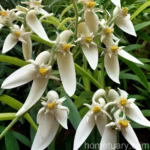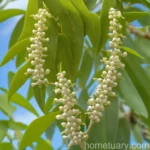The Fascinating Plant World: Exploring the Caucasian Wingnut (Pterocarya fraxinifolia)
Plants play a vital role in our lives, supporting ecosystems, providing food, and contributing to the beauty of our surroundings. As a plant scientist, I find myself continually captivated by the diverse and intriguing world of plants. Today, I am thrilled to delve into the fascinating realm of the Caucasian wingnut (Pterocarya fraxinifolia). With its distinct characteristics, intriguing uses, and essential care tips, this tree holds a unique place in the botanical world.
In this comprehensive guide, we will navigate through the various aspects of the Caucasian wingnut, from its culture and uses to essential care requirements. Furthermore, we will explore common diseases and pests, propagation techniques, and intriguing fun facts about this remarkable tree. Without further ado, let’s embark on our journey into the captivating world of the Caucasian wingnut.
What is the Caucasian Wingnut (Pterocarya fraxinifolia)?
The Caucasian wingnut, scientifically known as Pterocarya fraxinifolia, is a deciduous tree that belongs to the walnut family, Juglandaceae. It is native to the Caucasus region, specifically from the southern part of the Greater Caucasus mountains to the Lesser Caucasus. This majestic tree is renowned for its elegant stature, unique foliage, and distinctive winged seeds.
Key Takeaways – Caucasian Wingnut (Pterocarya fraxinifolia)
Before we delve into the specifics of the Caucasian wingnut, let’s explore the key takeaways that will guide us through this comprehensive exploration of the tree’s characteristics, care requirements, and uses.
- Scientific Name: Pterocarya fraxinifolia
- Common Name: Caucasian Wingnut
- Family: Juglandaceae
- Native Habitat: Caucasus region
- Type: Deciduous tree
- Notable Features: Distinctive winged seeds, elegant foliage
- Uses: Ornamental, timber, and environmental enhancement
- Care Requirements: Moderate water, full sunlight, well-draining soil
- Propagation: Seeds, hardwood cuttings
- Pruning: Minimal pruning required, primarily for shaping
- Common Diseases: Anthracnose, leaf spot diseases
Now that we have a comprehensive overview of the Caucasian wingnut, let’s delve into each aspect in detail, starting with its culture and uses.
Culture
Water
The Caucasian wingnut thrives in moderate moisture conditions, requiring regular watering, especially during its early establishment phase. While it is essential to maintain adequate soil moisture, it is equally crucial to ensure that the tree is not waterlogged, as this can lead to root rot and other detrimental effects.
Sunlight
When it comes to sunlight requirements, the Caucasian wingnut favors full sun exposure. It flourishes in locations that receive ample sunlight, allowing it to exhibit its full growth potential and showcase its ornamental features.
Fertilizer
For optimal growth and development, the Caucasian wingnut benefits from periodic fertilization. A balanced, slow-release fertilizer can provide the necessary nutrients to support the tree’s vigor and overall health. Additionally, incorporating organic matter into the soil can further enhance the tree’s nutrient intake and contribute to its well-being.
Soil
The ideal soil for the Caucasian wingnut is well-draining and rich in organic matter. It thrives in loamy, slightly acidic to neutral soil, with good drainage to prevent waterlogging. While it demonstrates a degree of adaptability, providing it with a fertile and moisture-retentive soil lays the foundation for its healthy growth.
Uses
The Caucasian wingnut holds multifaceted uses, ranging from its ornamental value to its contribution to the environment and timber industry.
-
Ornamental: With its graceful foliage, distinctive seeds, and elegant form, the Caucasian wingnut serves as an outstanding ornamental tree in parks, gardens, and landscapes. Its visual appeal and unique characteristics make it a captivating addition to diverse settings.
-
Timber: Beyond its ornamental value, the wood of the Caucasian wingnut possesses desirable qualities for various applications. Its timber is utilized in furniture making, joinery, and other woodworking endeavors, showcasing its versatility and practical utility.
-
Environmental Enhancement: As a native tree in the Caucasus region, the Caucasian wingnut contributes to the ecological balance and biodiversity of its natural habitat. Its presence supports local ecosystems and provides valuable resources for indigenous flora and fauna.
With its diverse uses and intrinsic value, the Caucasian wingnut holds a significant place in both natural and human-influenced environments.
Pruning
Pruning plays a role in shaping the growth and form of the Caucasian wingnut, although it typically requires minimal intervention. When pruning is necessary, it is advisable to conduct it during the dormant season to minimize stress on the tree and promote optimal healing.
Propagation
Container Propagation
Propagation of the Caucasian wingnut can be achieved through container cultivation, offering a practical method for expanding its presence in various settings. Hardwood cuttings and seeds serve as viable propagation techniques, providing avenues for nurturing new specimens of this remarkable tree.
Popularity
The popularity of the Caucasian wingnut extends to different regions, where it captivates enthusiasts, arborists, and nature lovers with its unique attributes. Its elegant form, intriguing seeds, and ornamental value contribute to its appeal in diverse landscapes and horticultural endeavors. As its recognition continues to grow, the Caucasian wingnut holds a place of distinction in the realm of ornamental trees.
Common Diseases
While the Caucasian wingnut exhibits resilience, it is susceptible to certain diseases that can affect its health and appearance. Two common diseases that may impact the tree are anthracnose and leaf spot diseases, which can manifest as foliar blemishes and affect its overall vitality. Recognizing the symptoms of these diseases and implementing appropriate measures for prevention and management can safeguard the well-being of the Caucasian wingnut.
Disease Diagnosis
Diagnosing diseases affecting the Caucasian wingnut involves careful observation of symptoms such as leaf discoloration, lesions, and abnormal growth patterns. Consultation with plant health specialists and diagnostic resources can aid in accurately identifying and addressing potential diseases, preserving the health of the tree.
Common Pests
While the Caucasian wingnut is relatively resilient to pests, it may encounter occasional challenges from pests such as aphids, caterpillars, and scale insects. Monitoring the tree for signs of pest infestation and employing targeted control methods can mitigate potential damage and maintain its vitality.
Botanist’s Tips
As a plant scientist, I offer the following tips to enthusiasts and caretakers of the Caucasian wingnut, encompassing various aspects of its care and cultivation:
-
Health Monitor: Regularly inspect the tree for signs of stress, diseases, or pest activity, facilitating early intervention and preventive measures.
-
Soil Management: Focus on providing well-draining, fertile soil to support the tree’s growth, ensuring a conducive environment for its root system.
-
Pruning Wisdom: Exercise prudence in pruning, intervening only as necessary to maintain the tree’s form and vitality without overly disrupting its natural growth.
-
Cultivation Insights: Embrace the tree’s adaptable nature and its preferences for moderate moisture and ample sunlight, accentuating its inherent resilience and aesthetic appeal.
Fun Facts
Introducing some intriguing facts about the Caucasian wingnut adds a layer of fascination to its already captivating presence:
- The winged seeds of the Caucasian wingnut are classified as samaras, showcasing a unique adaptation for dispersal and propagation.
- Its graceful foliage, reminiscent of the ash tree (Fraxinus spp.), contributes to its distinctive appearance and visual allure.
- The timber of the Caucasian wingnut boasts qualities such as durability and workability, positioning it as a valuable resource in woodworking and craftsmanship.
Links to External Resources
For those seeking further insights into the Caucasian wingnut and its diverse attributes, the following resources provide valuable information and perspectives:
- Royal Horticultural Society – Pterocarya fraxinifolia
- Missouri Botanical Garden – Pterocarya fraxinifolia
- The Morton Arboretum – Pterocarya fraxinifolia
- University of Florida IFAS Extension – Wingnut Tree
This array of resources offers in-depth insights, practical guidance, and botanical expertise, enriching the understanding of the Caucasian wingnut and its captivating presence.
In conclusion, the Caucasian wingnut (Pterocarya fraxinifolia) stands as a compelling testament to the diversity and enchantment of the plant kingdom. From its elegant foliage and unique seeds to its ornamental value and practical uses, this tree embodies a tapestry of attributes that captivate the imagination and inspire appreciation for the natural world. As we continue to explore the nuances of plant life, the Caucasian wingnut beckons us to embrace its grace, resilience, and enduring presence in the botanical realm.
With a blend of scientific insight, horticultural wisdom, and enchanting allure, the Caucasian wingnut emerges as a distinctive ambassador of the plant world, inviting us to celebrate its remarkable essence and timeless contributions to landscapes, ecosystems, and human interactions with nature.















